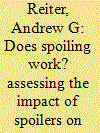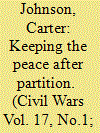|
|
|
Sort Order |
|
|
|
Items / Page
|
|
|
|
|
|
|
| Srl | Item |
| 1 |
ID:
144445


|
|
|
|
|
| Summary/Abstract |
Regardless of the outcome, civil wars are destructive events. They not only devastate the physical and human capital of a society, but also have a direct effect on state capacity. The capacity of the state is critical as it attempts to rebuild society and minimize the risk of a new civil conflict; yet, it is still not clear how civil war precisely affects state capacity. In general, we argue that incumbent victors are more likely to end with a stronger state when the conflict is short and the victory is decisive. In contrast, rebel victors require more time to build their internal capacity and thus have stronger states after a longer conflict, especially when they had access to lootable resources.
|
|
|
|
|
|
|
|
|
|
|
|
|
|
|
|
| 2 |
ID:
144447


|
|
|
|
|
| Summary/Abstract |
Scholars and policymakers argue that violent actors – termed ‘spoilers’ – pose a significant threat to civil war peace agreements. Yet existing research, which is overly reliant on single-case studies, has not effectively determined how prevalent spoiling is, or thoroughly examined what its ultimate effects are on peace agreements. This article draws on a newly constructed cross-national dataset of spoiling following 241 civil war peace agreements in the post-Cold War era to analyze spoiling. It finds that spoiling intended to terminate an agreement is not as common as typically assumed, but still plagues a sizeable number of peace agreements. Moreover, most actors who resort to this strategy typically fail in their goals and the agreement is not at risk, despite the high publicity and attention given to these threats. Yet particular types of actors, most notably paramilitaries and state security forces excluded from the agreement, can pose a significant threat to peace.
|
|
|
|
|
|
|
|
|
|
|
|
|
|
|
|
| 3 |
ID:
144446


|
|
|
|
|
| Summary/Abstract |
This study analyzes the effects of political violence on electoral behavior by focusing on one of the longest lasting ethnic conflicts in contemporary times, the Kurdish insurgency in Turkey. How do armed conflict and electoral institutions shape turnout in a civil war context? Building on an original data-set at the sub-national level, the study reaches two major conclusions. First, it shows rural displacement caused by political violence led to lower levels of turnout and severely hampered access to voting controlling for a wide range of socioeconomic and electoral system variables. Second, an unusually high electoral threshold aggravated this pattern of disenfranchisement and limited the avenues of nonviolent Kurdish political activism with negative implications for the resolution of the conflict.
|
|
|
|
|
|
|
|
|
|
|
|
|
|
|
|
| 4 |
ID:
144443


|
|
|
|
|
| Summary/Abstract |
Advances in the study of civil war have led to the proliferation of event count data, and to a corresponding increase in the use of (zero-inflated) count models for the quantitative analysis of civil conflict events. Our ability to effectively use these techniques is met with two current limitations. First, researchers do not yet have a definitive answer as to whether zero-inflated count models are a verifiably better approach to civil conflict modeling than are ‘less assuming’ approaches such as negative binomial count models. Second, the accurate analysis of conflict-event counts with count models – zero-inflated or otherwise – is severely limited by the absence of an effective framework for the evaluation of predictive accuracy, which is an empirical approach that is of increasing importance to conflict modelers. This article rectifies both of these deficiencies. Specifically, this study presents count forecasting techniques for the evaluation and comparison of count models' predictive accuracies. Using these techniques alongside out-of-sample forecasts, it then definitively verifies – for the first time – that zero-inflated count models are superior to comparable non-inflated models for the study of intrastate conflict events.
|
|
|
|
|
|
|
|
|
|
|
|
|
|
|
|
| 5 |
ID:
144444


|
|
|
|
|
| Summary/Abstract |
This paper examines partition as a solution to ethnic civil wars and modifies the ethnic security dilemma, suggesting that strong state institutions are more important than demographically separating ethnic groups to achieve an enduring peace. The paper starts with a puzzle: if ethnic separation is required for peace, how do some partitions that leave minorities behind maintain peace? The paper compares post-partition Georgia–Abkhazia, which experienced violence renewal within five years of the partition, with post-partition Moldova–Transnistria, which maintained peace. Both countries had ‘stay-behind’ ethnic minorities. The paper also disaggregates and compares the territories within post-partition Abkhazia, which contain ethnic Georgians: Lower Gali experienced violence while neighboring Upper Gali did not. The paper argues that state institutions create an incentive for ethnic minorities to collaborate with the state, regardless of minority preferences, and this helps maintain peace. However, preferences become important where institutions are weak and members of the ethnic minority have the opportunity to defect; this increases the likelihood of violence. The results build on the ethnic security dilemma by specifying micro-mechanisms and challenging the theory's reliance on intransigent ethnic identities in explaining the causes of post-partition violence.
|
|
|
|
|
|
|
|
|
|
|
|
|
|
|
|
|
|
|
|
|